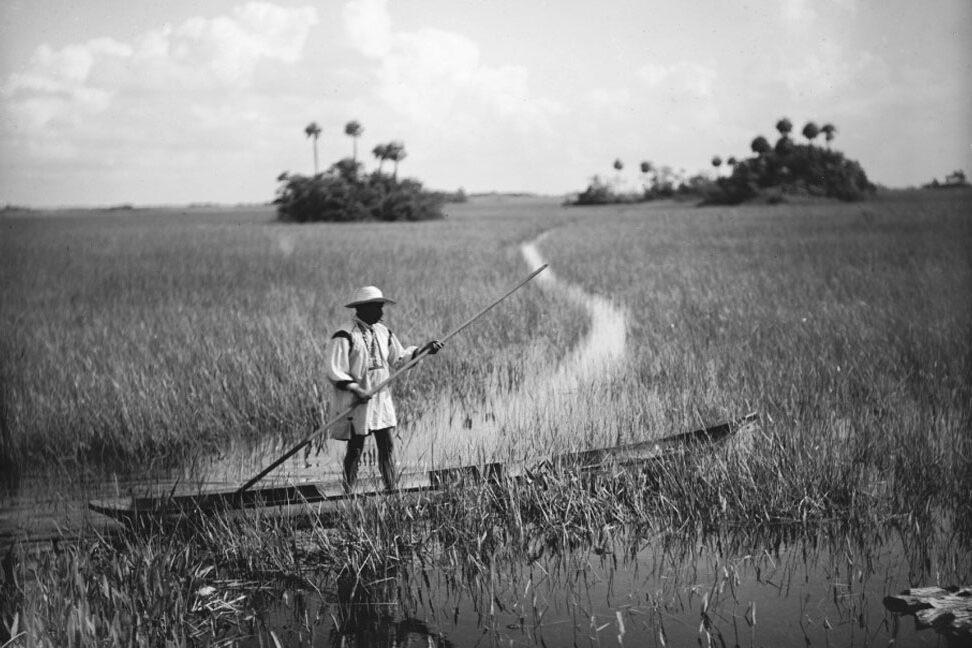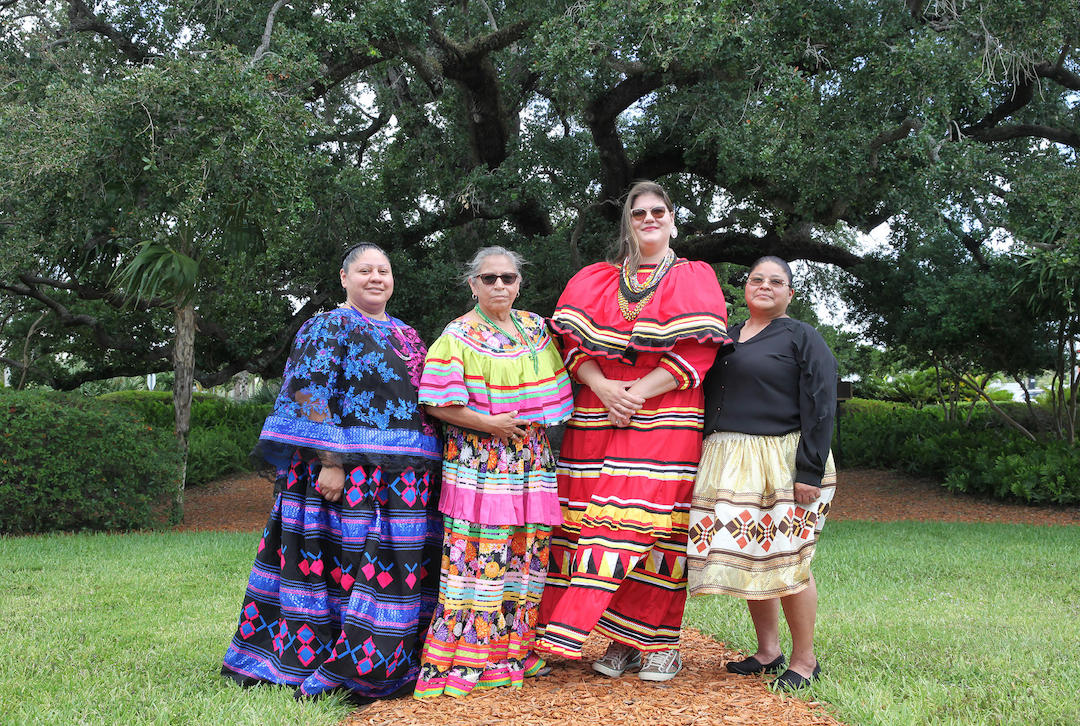
Seminole Spaces: The Secrets of the Water Highway
Welcome to Spring, Florida! As we dip further into 2024, the real change of seasons starts down here in the Sunshine State. We are referring to the shift from dry to wet season, of course! Water is the lifeblood of the state, supporting its unique sheet flow and ecological systems. We have talked about Dry Season, Wet Season, and the Everglades before on the blog. But, did you know that Seminole ancestors once used water just like we use roads?
This week, we will talk about an entirely unique Seminole Space: the Water Highway. Built over time by Seminole ancestors, these ancestral trails were incredibly important in maintaining trade and travel throughout the peninsula. But, a changing Florida put an end to these busy, thriving waterways. Learn why, and how the Seminole Tribe of Florida is trying to help restore this unique and important ecosystem today.
Below, you can see Charley Tommy poling a canoe in 1907. Visible behind him is a canoe trail leading to Tommy Osceola’s second camp. Julian Dimock snapped the image on a trip intended to explore the interior of the Everglades and Big Cypress Swamp. Interestingly, Tommy warned the Dimocks that the trip would fail due to low water. True to his prediction, it did, and the Dimocks were unable to complete their intended trip (Hidden Seminoles 37). In our featured image, you can see another shot of Charley Tommy taken in the same spot. You can learn more about Julian Dimock and his photography in a previous blog post.

2012.3.34, ATTK Museum
Ancestral Trails
The Everglades ecosystem is unique, supported by the ebb and flow of a sheet of water. This water feeds the marshy, swampy, ever-shifting Everglades that we know and love! But the environment is also harsh, and incredibly difficult to navigate without the modern conveniences we now depend on. Additionally, the Everglades of today is much different than it was a couple hundred years ago. Dredging, damming, and shaping the land has altered the beautiful natural landscape, as well as the sheet flow. Prior to this, the interior of the state was incredibly hard to maneuver.
So, how did Seminole ancestors get around? The water highway of course! For as long as they have been on the Florida Peninsula, Seminole ancestors created and maintained a network of trails utilized for travel and trade (Seminole History Stories, October 2023). They had extensive knowledge of the waterways and routes through the Everglades. Sometimes the trails could be traversed by foot, and other times they required the use of wetland canoes.
Seminole dugout canoes were incredibly important for transportation throughout history. Seminole ancestors depended on water to survive; water that fed their crops, provided their food, and allowed them to move throughout the peninsula. Seminole ancestors, then Seminoles, would pole canoes through the sawgrass, travelling between inland camps and earthwork settlements. Skilled artisans make these canoes out of bald cypress. Cypress heartwood contains a special oil (cypressene) that is resistant to water and rot. Seminole canoes have an upswept stern and pointed bow to cut through sawgrass, and are propelled by poling. They continue to be an important tradition and tool today.
As many Floridians know, water is an everchanging compound. Therefore, as the water levels rose and fell throughout the season they would need to constantly be maintained. Otherwise, the trails would overgrow or be lost. But, this also meant the trails themselves could change and shift to new needs or pressures.
Spanish Contact and Beyond
The Seminole ancestors’ relationship with water, and the Everglades, was an incredibly intimate one. They survived through hunting, foraging, fishing, and farming the land. Doing so fostered a wealth of knowledge of how to live and flourish in this environment. A modern Seminole example would be Charley Tommy’s warning to the Dimocks, mentioned above. Tommy knew the trails and the time of year meant their journey was futile. It is this same intimate knowledge of the Everglades, and the Water Highway, that helped Seminoles and some Seminole ancestors to resist colonization as long as they could. Unfortunately, many of the Seminole ancestor tribes would fracture due to Western pressure and warfare.
The Spanish made contact with the Florida Peninsula in 1513, and the ancestral trails and vast knowledge of the wetlands are one of the key elements that helped that resilience in the face of colonization. For, “the Spanish forces did not know how to maneuver in the wetlands and were not able to venture into the Florida interior without heavy losses due to disease and the hazardous environment.”
This trend would continue as more and more Western colonizers tried to gain a foothold in wild Florida. Thus, “history repeated during the Seminole War, as American forces were confounded and regularly ambushed and outflanked by Seminole movements using the wetland trails. Following the war, the Seminole remaining in Florida used the trails to carefully avoid American settlers and continue to move freely throughout the region” (Seminole History Stories, October 2023).
During the Seminole War period, American forces were particularly confounded with how to navigate these wetlands. Fort Henry, used as a supply post during the Second Seminole War (1835-1842), was even strategically positioned so that American forces could observe these Seminole canoe trails (4 Dec 1983, Miami Herald). But, Seminoles remained unconquered, despite these measures to try and gain strategic advantage over them. Seminoles never signed a peace treaty with the U.S. Government.
Reshaping Florida and the End of the Water Highway
In 1918, a group of reporters, along with a group of professionals including a civil engineer, tried to travel from Fort Myers to Miami, linking up the new Tamiami Trail. They got rerouted by something along the way and tried to find a Seminole camp to ask directions. During their journey, the author described their efforts, saying: “A Seminole canoe trail was followed, along which several abandoned canoes were stranded high and dry. The day of the Seminole canoe is evidently numbered” (Jun 22, 1918, News-Press). Sadly, this observation proved to be true.
During the first three decades of 20th century, the end of this Water Highway would be set in stone. Three main factors led to the end of the Water Highway, and the end of the Seminole isolation from the Western world.
First came the development of new railway systems throughout Florida. Along both coasts, railways began to bring supplies and people. Eventually, they would also link east and west Florida, cutting off sections of the swamp from necessary sheet flow. Second, with the influx of new people came a desire to develop the land itself. Massive drainage and canal projects at the turn of the century would drastically lower water levels, allowing for land development.
But, it would have an increasingly negative impact on the Everglades ecosystem. The first embankments around Lake Okeechobee were placed in 1915. Eventually, Herbert Hoover Dike would be constructed in the 1930s. Finally, the Tamiami Trail would slice straight through the body of the Everglades. Tamiami Trail (US 41) would be finally completed in 1928 and link the east and west coasts by civilian roads.
All of these changes would drastically impact the Everglades ecosystem, in particular the sheet flow that Marjory Stoneman Douglas famously termed the “River of Grass” in 1947. As the Everglades dried out, the old familiar trails became cut off or even disappeared. Canoes could no longer travel unimpeded. But, Seminoles would continue to use the trails that were still available to them for as long as possible, particularly between Seminole communities. Below, you can see Seminole cattlemen herding cattle between Big Cypress and Immokalee, circa 1910.

Via Stofthpo.com
Everglades Restoration
Most likely, the Everglades will never again be what it once was. But, many people out there are working hard to improve the health and wellness of the Everglades, and those who live in it. The Seminole Tribe of Florida is committed to Everglades Restoration, working on a number of projects and committees that are pushing the health of the Everglades to the forefront. Many Seminole and Miccosukee people understand the importance of this restoration, to protect the ecosystem for generations to come.
In 2023, just a day before attending that year’s Everglades Coalition conference, Councilwoman Mariann Billie shared her thoughts. “Everglades restoration is important to our tribal people because the Everglades was and is our home, “she stated. “For hundreds of years, the Everglades took care of the Seminole and Miccosukee people so I believe it’s important for tribal citizens to voice their concerns as well as share our Traditional Ecological Knowledge (TEK) to help ensure that efforts to make amends to the land is conducted in an appropriate and respectful manner.”
Just over a month ago, at the 2024 Everglades Coalition Conference, representatives from both the Miccosukee Tribe and the Seminole Tribe of Florida were present to make their voices heard. Tina Marie Osceola, current Tribal Historic Preservation Officer (THPO), Director of the Tribal Historic Preservation Office (THPO), and Acting Executive Director of Operations of the Seminole Tribe of Florida emphasized that, “We have to take a step back and understand this is about legacy, What we do with the state today will matter in 100 years when none of us will be here.”
This wet season, we encourage you to explore ways you can ethically enjoy this one-of-a-kind ecosystem, as well as get involved to protect it in the long term. We also encourage you to support local resources that have made Everglades restoration a priority and choose to protect our natural environment.
Interested in more information about Historic Seminole Trails? Check out the Seminole Tribe of Florida’s Tribal Historic Preservation Office’s Big Cypress Historic Trail Storymap.
Interested in more Seminole Spaces? Look back on our blog for more installments of this series!
Additional Sources
Milanich, Jerald T., and Nina Root. Hidden Seminoles: Julian Dimock’s Historic Florida Photographs. University Press of Florida. 2011.
Author Bio
Originally from Washington state, Deanna Butler received her BA in Archaeological Sciences from the University of Washington in 2014. Deanna moved to Florida in 2016. Soon, she began working for the Seminole Tribe of Florida’s Tribal Historic Preservation Office. Deanna was the THPO’s Archaeological Collections Assistant from 2017-2021. While at the THPO, Deanna worked to preserve, support, and process the Tribe’s archaeological collection. She often wrote the popular Artifact of the Month series and worked on many community and educational outreach programs. She lives in Lakeland, FL with her husband, two sons, and dog.



